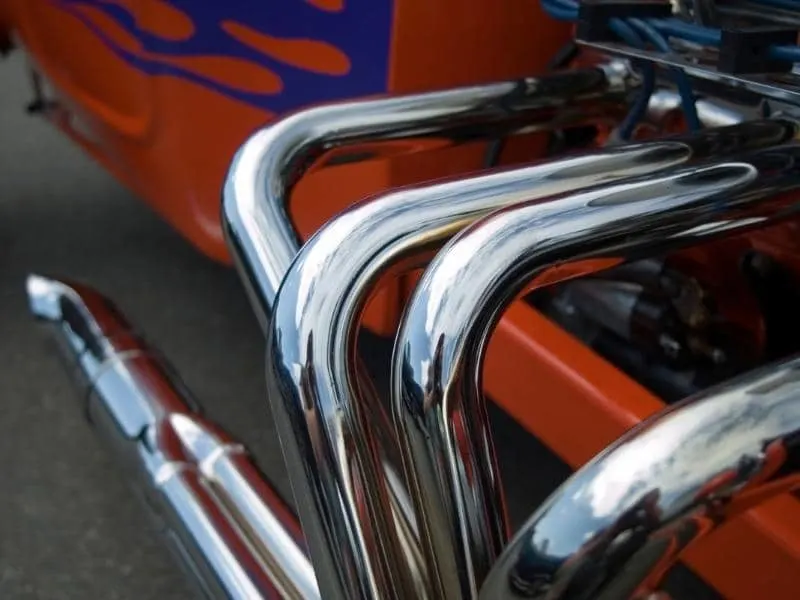Do you enjoy towering over other drivers, or do you dread climbing into a high-windowed car? Those with claustrophobia should avoid headers in cars if they face the condition. In the summertime, they can become excessively hot.
So, how hot can a header get? Here’s the answer.
How hot do headers get?
The headers reach temperatures between 500 and 1000 degrees Fahrenheit. It will be approximately 500 degrees Fahrenheit in the automobile. Motorcycle temperatures may approach 1200 degrees. High-quality thermal printing headers can make headers heated.

However, in the heat, headers might become a problem. Heat would be a bad thing for a contender like the Toyota Evora, and if you plan on conducting burnouts on your wheels or using them to drill holes, you should prevent it.
Turbo headers:
Turbo headers may become quite hot, especially when used in a high-performance engine. Turbo headers may reach temperatures of 1200 degrees Fahrenheit.
Harley headers:
The headers on Harleys can become excessively hot. They are made of aluminum and titanium flanges. Quite hot to the touch on the inside. Harley headers can heat up to 500 degrees Fahrenheit.
Stainless steel headers:
Stainless steel headers can withstand temperatures of up to 900 degrees Fahrenheit. The reason for this is that stainless steel can be hotter than copper when exposed to direct flame.
It does not oxidize in the same manner that copper does, resulting in milder types of oxidation such as sulfide precipitation or pitting (the rusting process).
Ceramic coated headers:
Ceramic-coated headers grow excessively hot, reaching temperatures of up to 3500 degrees Fahrenheit. When used, ceramic-coated headers become quite hot, and you should always ensure that they are well cooled before removing them from your car.
When the header grows too hot to handle, it might damage the coating permanently and perhaps start a fire.
How hot do engine exhaust headers get?
Temperatures in engine exhaust headers can exceed 1,000 degrees Fahrenheit. This is why they are composed of heat and pressure-resistant materials such as stainless steel or aluminum. Here are some examples of common vehicles and their typical engine exhaust temperatures.
On a car:
Exhaust headers on an automobile may achieve temperatures ranging from 500 to 900 degrees Fahrenheit. And it is determined by several criteria, including the brand and model of your vehicle, the amount of load on the engine, and the temperature of the day.
Exhaust headers of an automobile can get hot, although it is unlikely to do any harm. Most automobile exhaust systems are built of strong gauge steel and aluminum that can withstand high temperatures.
On a motorcycle:
The temperature of the exhaust from the engine Motorcycle headers may reach temperatures of up to 1200 degrees Fahrenheit. When the engine is running, the exhaust headers become quite hot.
The heat shields serve to keep the header from warping or losing structural integrity, but you should still be aware of how near you are to them.
On an sbc:
Engine headers on single-cylinder small blocks may achieve temperatures of up to 700°F. They are also often made of stainless steel, aluminum, or a specific alloy engineered to withstand high temperatures near the exhaust manifold.
Why do my headers get hot?
When the headers on your automobile are heated, it implies the engine is working very hard. This can be caused by several circumstances, including prolonged idling or driving on lengthy motorways. Here are some of the reasons why your headers may become heated.
It takes the heat from the engine and directs it out:
The headers in your automobile grow heated because as the engine gets hot, it draws heat from the engine and makes a path for it to escape. And the header is made up of many tubes that gather and dissipate heat.
It increases the pressure of gasses:
When your car’s headers become heated, they retain high heat and raise the pressure within, which is why it’s crucial to take note with caution. Furthermore, because of the increased pressure and heat, internal volumes will expand to a greater length.
It helps in getting more power from your engine:
You may increase the power of your engine by removing extra heat and enabling it to travel in its intended route. We enhance gas mileage by boosting airflow since there is less friction and the temperatures are three times greater than normal.
It can help in fuel efficiency as well:
The ability of the engine, especially older ones, to produce more power can be improved by raising the temperature of the air that it takes in. When operating at temperatures 25 percent lower than normal, airflow is increased by about 20 to 25 percent.
The oxygenated gas results in a boost in fuel efficiency of around 10–15 percent, which is a respectable rate.
Do headers get hotter than manifolds?
The temperature of the headers is noticeably higher than that of the manifolds. This is because a header carries a greater quantity of air and oil, both of which may rapidly become hot if the engine is not operating as it should.
In contrast, a manifold relies on direct airflow to keep it from overheating and cools itself down when it becomes too hot.
The restriction of airflow caused by many headers’ usage of metal plates that sit directly above the engine block leads to an increase in the temperature of the engine.
Because certain manifolds rely on air ducts and vents to allow heat to escape, it’s possible that some manifolds don’t become as hot as a header would, which is in direct contact with the engine.
How hot does header wrap get?
Header wrap can become very hot during manufacturing and may cause minor discomfort. The distortion of the header might reach 1200 degrees F. It is critical to wear suitable attire when using it, and if any bad reactions occur, cease usage immediately and seek medical treatment.
However, because header wrap is intended to have a useful range of 200-300 degrees F, the effects should be minimized.
It is crucial to remember that it can grow quite hot, creating bad responses in certain people as well as those who are accustomed to the heat produced by exhaust systems and headers.
How do I keep my exhaust header cool?
You can keep your exhaust header cold by keeping it clean, adding an air-conditioning system, and employing insulation. Here’s how to protect your exhaust header from overheating.
Proper cleaning:
Clean the exhaust header regularly to avoid corrosion and buildup. To clean metal surfaces, use a degreaser or abrasive cleanser. Also, avoid applying aggressive chemicals that might harm the header wrap.
Install an air conditioning:
Install an air conditioner to keep your header cool during hot weather. Install it in a spot away from direct sunlight or heat-sensitive regions, and ensure the fan is switched on when the automobile is turned on.
Use insulation:
To keep the exhaust header cold, use some form of insulation. You can use fiberglass or spray foam insulation, and make sure it is properly fastened to the header wrap. Also, make sure there is sufficient air so that the insulation fumes may escape.
Install an exhaust header cooler:
Some firms manufacture exhaust header coolers, which aid in keeping the header cooler. These gadgets employ a fan to produce a breeze and are quite simple to install. They are, nevertheless, more expensive than other solutions.
Set up a heat shield:
Consider putting a heat shield if you’re concerned about the warmth of your header. This device is composed of metal or plastic and covers the header region to keep it cooler. This sort of equipment also aids in keeping the header tubing and exhaust headers cold.
Additional Suggestions:
These are several techniques to improve the temperature of your exhaust header, although each approach is impacted by the circumstances:
In hot weather, a coolant system may be recommended; if it’s too cold outdoors, insulating with heat tape will assist in naturally decrease the temperature of your pipes, so don’t worry about what type of insulation you need for this heavy traffic.
Final Thoughts
The temperature of headers can reach up to 1000 degrees Fahrenheit. However, ceramic-coated headers can withstand temperatures up to 3,500 degrees Fahrenheit. Watch the headers on your vehicle and do whatever it takes to prevent them from getting too hot, including opening the hood.

I am an automotive enthusiast and have been interested in cars since I was a little kid. I have worked in the automotive industry for many years and have extensive knowledge of vehicles and their engines. I am a father of two and I love spending time with my family.
Read more about the author here.
